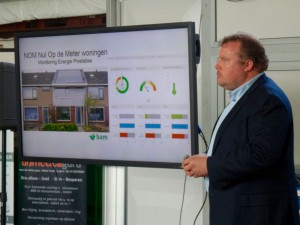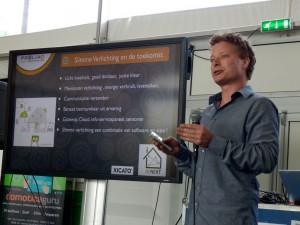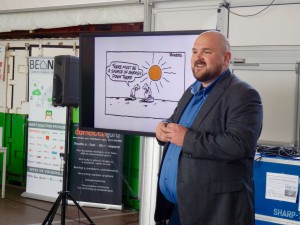On Friday the 17th of June the event “Smart Home” took place @ FabCity at the LearningLab – located on Java eiland in Amsterdam. FabCity is a temporary and freely accessible campus at Java eiland which was created in the context of the Dutch chairmanship of the European Union in 2016. The Campus consists of innovative stands and installation for the development of the sustainable city of tomorrow. The campus is open between April 11 until June 26.
The afternoon started with a tour of FabCity, led by guides which showed all the participants that all the aspects of life, living, building can be done differently, and are less, or even absent from damaging our environment. After the tour the participants gathered at the LearningLab where the companies involved in the smart conversion of the accommodations and offices of Finch Buildings presented themselves. All of them describe the same goals and principles. Living in the future should become more sustainable, healthier, more energy efficient and self-sustaining.

Jurrian Knijtijzer – Finch Buildings
The kick-off presentation was done by Domotica.Guru, the expert in converting existing and new accommodations into wireless smart. DomoticaGuru works with the core technology provided by BeNext and combines all the major aspects of an accommodation within one app designed to connect these aspects in an user friendly way. DomoticaGuru’s Arno Rootsaert explained why you should make your living space “smart”. More comfort, security, energy saving, healthier living climate, and adaptable to meet the changing needs through the course a lifetime are all relevant. The Internet of Things is already creeping into consumer’s lives: A smart thermostat, smart lighting etc. But who puts the resident first? Many manufacturers are developing their own app, and the residents? They are turning dizzy from all the different apps on their smartphones which lack cohesion or neglect to work properly. The challenge is to convert homes to smart in a way which is appealing to the resident, where the resident only benefits and gains control of its home.
Jurrian Knijtijzer from Finch Buildings presented his sustainable, adaptable and stackable accommodations made from solid wood, which sets a new standard for building homes. Circular construction has been thoroughly thought through, the modules of Finch Buildings are adaptable and can be used as senior accommodations, student housing, hotels, and living facilities for residence permit holders. The modular build system is both temporary and permanent applicable and are completely circular. This means that there is no need to look for long term solutions. If the modules were to be unusable in 50 years, they can be recycled with ease. This way the materials maintain their value.
The buildings by Finch Buildings are cheap and easy to relocate and can be transported via public roads. Because all the modules are plug and play, they can be paired to create small or big living spaces. Every module has its own facilities, like a kitchen, bathroom and meter cupboards. The modules are interchangeable and have an internal height of 2.8 meters. The modules are completely electrical, no gas connection is available. They only use electricity is sustainable, generated, for example, by solar panels.
Taking into account the force the wood structure can take, five story buildings are feasible. Building the modules from solid wood, in contrast to materials like sheet-rock and concrete, has its advantages, the living conditions are healthier. Finch Buildings has different projects in development, in and out of the Netherlands.

Edwin van Kessel – BeNext
Edwin van Kessel of BeNext, the independent Smart Solution developer from Amsterdam, showed how BeNext supports fitters with their smart ICT solutions. By integrating various meters with their Smart Home and Cloud solutions, they make sure that installers can guarantee the energy performance of “Nul Op de Meter” (zero-on the-meter, or “NOM”) homes. BeNext creates insight into electricity, hear, water, gas, and yield of installations and facilitates information and service portals for fitters and real estate service organizations. These are used to monitor these facilities off-site and real-time. This ensures that management and maintenance of installations in accommodations are done more efficiently, and in case of failures or disasters can be dealt with pro actively. Some zero-on the-meter examples are given. BeNext also developed a complete solution for wireless reading and monitoring of a water meter including a LoRa network on Aruba.
BeNext also developed a complete solution for wireless reading and monitoring of water metersm including the LoRa network on Aruba. BeNext developed, at FabCity in cooperation with Proliad and Xicato, a pilot for the offices of Finch Buildings, for controlling the Xicato LED lighting via the Dali protocol, which will make this lighting standard accessible and affordable for usage in homes.

Wouter Verhoeven – Proliad / Xicato
Wouter Verhoeven of Proliad took the floor to tell about what qualitative LED lighting stands for and why he prefers using LED lighting from Xicato in his projects. Xicato is good quality LED lighting because of the colour retention and the guaranteed burning time. It mainly works with remote phosphor which has less influence on temperature. Looking at the projects by Proliad you can see immediately that you are dealing with a specialist, the van Gogh museum, the Dom tower in Utrecht, the Voorlinden museum, are all projects by Proliad. Through their own design department, 3D-printer, computer guided milling machines, they create fittings.
According to Wouter more and more lighting in living facilities are turning towards the 48V, which has nothing but advantages. And what about the creation of smart lighting? BLE Bluetooth Low Energy is already applicable however for accommodations we tend to think about feelings and experiences, because you can influence people with light. Give light a more blueish look during the summer which makes it feel cooler, and during the winter use more yellow and red shades which tend to feel warmer. People are sensitive to these kinds of changes and we should take advantage of that fact.
Of course the local generation of energy could not be absent, and for that Roel van den Berg of Autarco assisted. Autarco installed a solar power installation on the roof of Finch Buildings. Autarco works with recognized fitters and goes one step beyond the service provided by the traditional solar power industry. Autarco supplies complete solar power systems and provides a guaranteed minimum generation. An interesting development is that Autarco connects seamlessly to the Smart Home platform of BeNext, which means that generated electricity can be applied efficiently. So when in 2020 netting arrangements in the Netherlands change, or energy costs turn dynamic, this installation can distribute its energy automatically to the most cost effective components, which is good for the wallet.

Niels van Lingen – ThermIQ
But what do you need all that electricity for? In France and Norway they think they have the solution. They are already used to electric heating, where in the Netherlands we rely on natural gas – like there is nothing else. By generating electricity via the sun we are turning our focus more and more towards electrical solutions, so we can leave our gas era behind us. We are living in homes that are better insulated which means it requires less power to heat them, and this way infra-red heating seems like an ideal solution to keep it at a comfortable temperature. Niels van Lingen from ThermIQ held his plea on the heating of homes with electric infra-red panels, he provided calculation examples of gas versus infrared installation and showed all the benefits of infra-red heating. Everyone should be familiar with infra-red heating since the sun does it. The air does not get heated, but the mass does, which makes it that we have cool air, approximately 18 degrees Celsius, in our homes, which keeps us focused but feels like a comfortable 23 degrees.
The plenary presentations were followed by a visit to Finch Buildings, a living space consisting of two attached units, the office and a student apartment downstairs.
We finished the afternoon in the greenhouse of FabCafe, where the popup restaurant OnsEten served food based on ingredients from farms or vegetable gardens, because in the city of the future our food will evolve as well.
“I have enjoyed my visit to FabCity and the Smart Home presentation. I was impressed by the human capital, the entrepreneurship and the innovating these Duchies have created.
I was speechless” – Ir. René de Brouwer of Evanston Consulting.
Download links below of a few of the presentatiosn
BeNext: The Smart Solution Provider for connected Smart Homes.
Edwin van Kessel
DomoticaGuru: Connecting Things en ook de bewoners.
Arno Rootsaert
Proliad / Xicato, Verlichting van de toekomst, gegarandeerd, gezond en slim.
Wouter Verhoeven
Autarco, De toekomst van eigen energie opwekking.
Roel van den Berg
